The Royals will be hosting the Washington Nationals this week, and my partner Tim Sear has scored tickets for us for tonight’s game. As of today, the best records in baseball belong to the Cubs (17-6) and the Nationals (17-7). I am looking forward to seeing Bryce Harper who was on the cover of Sports Illustrated at age 16 and National League MVP last year at age 22. His idols are Mantle, Rose and Brett. He wears #34 because 3 and 4 add up to Mantle’s #7. Here is what Brett had to say about Harper’s MVP season (click here, 37 seconds). This past weekend, the Nationals swept the Cardinals in St. Louis, but Harper was 0 for 11. So look out. And on Wednesday afternoon, the Royals will face Stephen Strasburg (4-0). They are two of the most hyped players of recent years with Strasburg being the #1 overall draft pick in 2009 and Harper the same in 2010.
For the nostalgia buffs, this seems like a good time to review the franchise history of the nation’s capital.
Washington Senators (Part 1): This version of the team lasted 60 years in DC (1901 to 1960). The official name went from Senators to Nationals and back to Senators, and the names were used interchangeably by fans and sportswriters (and often, the “Nats”). Clark Griffith owned the team from 1920 to 1955, and his nephew Calvin Griffith then took over the team. The Senators played in Griffith Stadium, originally known as National Park when it was built in 1911. The team had some success in early eras, appearing in the World Series in 1924, 1925 and 1933. The most famous Senator was pitcher Walter (“Big Train”) Johnson who won 417 games from 1907 to 1927. He was one of the five inaugural members to the Hall of Fame and was one of the several Hall of Famers to have his card in the vintage T206 series issued from 1909 to 1911 (the series that includes the $2.8 million Honus Wagner card):
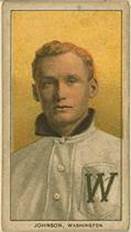
The team won only one World Series (1924), but it offers a good story of a Royals-style come-back. In Game 7, the Senators were down 3-1 in the 8th inning to John McGraw’s NY Giants. The bases were loaded, and Bucky Harris hit a ground ball toward Giants 3rd baseman Freddie Lindstrom. The ball hit a pebble for a bad hop over Lindstrom, and two runners scored to tie the game. Walter Johnson entered the game for the Senators in the 9th and pitched four scoreless innings. In the bottom of the 12th, Muddy Ruel popped up directly over home plate. The catcher dropped his mask, but failed to toss it far enough and tripped on it and missed the ball. Ruel then doubled and scored the winning run on a ground ball that unbelievably took yet another bad hop over Lindstrom at 3rd base.
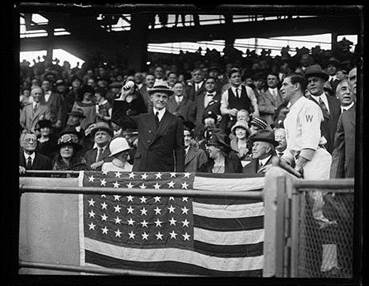
Calvin Coolidge Opens the 1924 World Series
After its last World Series appearance in 1933, the club rarely finished in the first division. As a young Yankee fan in the early 50’s, I often heard the common joke that Washington was first in war, first in peace and last in the American League.
The futility of the team was used as a theme in a 1954 book I read as a teenager: The Year the Yankees Lost the Pennant. A movie and play followed. A very brief synopsis: Joe, a middle-aged Senators’ fan, decides to help his team by bargaining with the devil – he exchanges his soul to become a young superstar for the Senators. He leads the he team to a tie with the Yankees with one game left in the season. The devil is (of course) a Yankees fan, and after failing to woo Joe with the temptress Lola, looks for another way to stop Joe in the final game. With the Senators up by one with two out in the ninth, Yankee Mickey Mantle smashes the ball to the outfield. As Joe races to make the catch for the final out, the devil converts Joe back to his paunchy former self, but the now-older Joe lunges and makes the catch. The Senators win the pennant and Joe returns to his former life, soul intact. If this all sounds familiar, you have probably seen Damn Yankees (and heard “You Gotta Have Heart” and “Whatever Lola Wants”).
Washington Senators (Part 2): After the 1960 season, Calvin Griffith moved the team to Minnesota. The American League immediately put an expansion team in DC to keep Congress happy and not risk losing baseball’s antitrust exemption. After playing one year in Griffith Stadium, the team moved to the new Robert F. Kennedy Stadium. These new Senators played in DC from 1961 to 1971 and then migrated to Texas to become the Rangers. Ted Williams managed the Senators from 1969 to 1971 and also their first year in Texas.
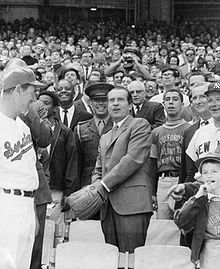
Ted Williams and President Nixon
Opening Day at RFK – 1969
Washington Nationals: Washington had no team from 1972 to 2004. In 2005, after having lost two teams to other cities, Washington turned the tables and welcomed the former Montreal Expos to town. They are now known as the “Nationals” and “Nats” but not the “Senators.”
As of today, and also as projected for the season, fans in DC can say that their city is first in war, first in peace and first in the National League East. There may be some disagreement on the war and peace parts.
As you may recall, a few years after the Senators (Part 2) moved to Texas, they were sold to new owners and George W. Bush became the managing general partner of the team. Here is President Bush at RFK throwing out the first pitch to open the Nationals’ first season in 2005:
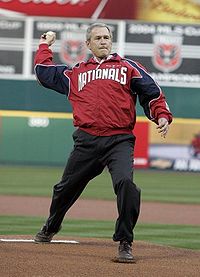
And to give equal time, here is President Obama throwing out the first pitch at Nationals Park in 2010 (the team moved from RFK to the new stadium in 2008). Note that the President is wearing a White Sox hat, and he is no doubt happy that they are giving the Royals a tough run in the AL Central. Obama’s political advisor David Axelrod has been tweeting about a 2016 Red Line World Series between the White Sox and Cubs. Some predecessors: the 1944 Streetcar Series (Browns/Cards), the 1985 I-70 Series (Royals/Cards) and several Subway Series in NY (before the Giants and Dodgers left, plus the Mets and Yankees in 2000).

The Cover: That cover from 2009 when Harper was 16:
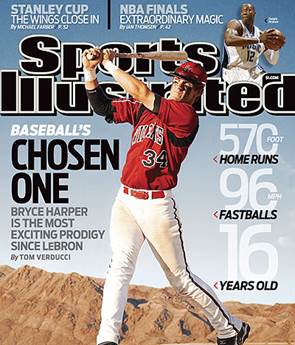
Go Royals! Please.